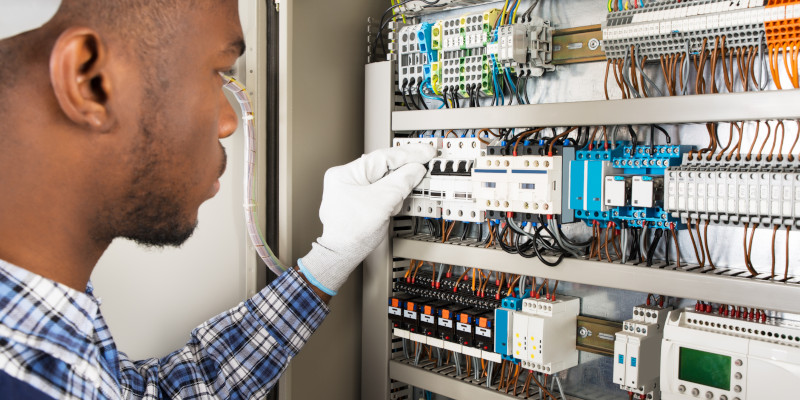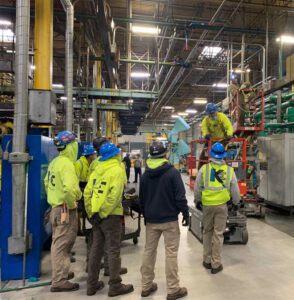Electricians get electrical power from the grid to homes and businesses. They follow blueprints, test and inspect components and equipment, install wiring and lighting, and perform maintenance and repairs.
Important skills include color vision to identify wires, communication skills to interact with customers, and physical strength to move heavy components. Electricians also need to be concerned about safety.
Electricians install, repair, and maintain electrical wiring, fixtures, and equipment in all types of buildings. They work with both residential and commercial structures and can be self-employed contractors or employees of an electrical company. They often need to communicate with construction workers and clients to provide quotes, discuss project details, and determine the best course of action for installation.
Many electricians have a high school diploma and receive their training through an apprenticeship program that lasts four to five years. Others attend a vocational-technical school that offers certificate programs in electrical technology or other related fields. While attending a vocational school isn’t required for becoming a licensed electrician, it can offer valuable training that can help students gain a competitive edge when applying for an apprenticeship or other job opportunities.
The first stage in an electrician’s career is to learn how to safely handle electrical equipment and wiring. This includes understanding the proper safety precautions when working with electricity and knowing how to properly use tools to avoid injury or death. Electricians also need to understand how to read blueprints and other documents and be able to follow them when installing or repairing wiring.
During the installation process, electricians often need to collaborate with other construction professionals, such as engineers and architects, to ensure that electrical systems are properly designed and installed. They also must be able to effectively communicate with clients and end-users, offering guidance on electrical usage, safety precautions, and energy-saving practices.
In some cases, electricians may need to troubleshoot or repair existing electrical systems. This can include replacing old or damaged wiring, receptacles, and switches, or updating circuit breakers or transformers. They might also be responsible for maintaining or ensuring compliance with applicable building codes and regulations.
Some electricians may specialize in specific areas of the industry, such as residential, commercial, or industrial. Residential electricians install and repair wiring in homes and other dwellings, while commercial electricians work on larger-scale installations in offices, retail stores, schools, and other commercial spaces. Other specialty electricians include marine electricians, hospital electricians, and theater electricians, who are tasked with hanging, focusing, and operating stage lighting instruments and equipment.
Maintenance
Electricians are responsible for ensuring that the electricity flowing through a home, office, or industrial building remains safe and functional. They do this by conducting routine inspections, testing, and repairs on a regular basis. The process involves using devices such as voltmeters, oscilloscopes, and ohmmeters to examine electrical systems and equipment. They also review blueprints and schematics to understand the placement of wiring. These electrical industry professionals typically have a large arsenal of tools and supplies that they use to complete their work.
Most facilities will have a maintenance plan or schedule that they follow. This may be based on government regulations or on the type of equipment in the facility. For example, hospitals must ensure that their medical equipment is serviced at a certain interval to keep it in working condition and safe for patients.
The process of maintenance is critical because minor issues can escalate into major problems and even a power outage. This can be devastating to businesses that rely on the flow of electricity for their operations. In some cases, a business may be forced to shut down for hours or weeks until the problem can be resolved. This can result in lost revenue for the company.
Preventive maintenance can help reduce the number of unexpected issues and downtimes. This can save money in the long run as well as improve productivity and efficiency. Electrical preventive maintenance is particularly important for businesses that rely on high-tech machinery, like manufacturing companies and hospitals. This type of equipment often requires a lot of power and must be serviced at regular intervals to keep it running properly.
Performing preventive maintenance can also help reduce the likelihood of fires in industrial settings. According to the National Fire Protection Association, lighting equipment is the leading cause of fires in these facilities, followed by heating equipment. Preventive maintenance can keep these problems from occurring by catching them early on.
Troubleshooting
The troubleshooting process is a logical and systematic way to analyze a circuit and determine what is causing its faulty operation. It can be a very useful tool for maintenance personnel, who must often deal with malfunctioning equipment in a timely manner to avoid costly downtime and lost productivity.
One of the most important steps in the troubleshooting process is to gather as much information about the problem as possible. This includes knowing how the equipment is supposed to operate as well as identifying any technical documentation that may be available. It is also important to understand the role of malfunctioning equipment within the overall system. This can help you narrow down the source of the problem to a specific component.
Once you have gathered as much information as possible, it is time to start eliminating the possibilities. Use your initial observations to create a list of all the faults that could be responsible for the malfunction. You should then prioritize this list based on the probability that they are the cause of the issue. If a component is very unlikely to be the problem, it should be eliminated from your list.
After you have ruled out all of the potential causes, it is time to perform some tests on the equipment to determine what the actual problem is. This can be done with test instruments such as a multimeter or a volt/ohm meter. You will also want to make sure that you are following your organization’s safety rules and procedures when working on electrical equipment.
It is important to note that many times the root cause of the problem will be obvious and can be identified with careful observation and a little reasoning. For example, it may be as simple as a GFCI receptacle or circuit breaker being tripped or a fuse blowing. In these cases, the repair is generally quick and inexpensive.
However, some problems are more complex and require a deeper analysis of the circuit. In these cases, it is helpful to have a thorough understanding of the components in the circuit and how they interact with each other. This can be accomplished by studying a schematic diagram of the circuit or utilizing the information provided by the manufacturer.
Licensed
Licensed electricians, also known as master electricians, have undergone extensive on-the-job training. This is accomplished through a trade school or an apprenticeship program that lasts up to four years. Apprentices receive paid employment while learning the trade, and some even get college credits.
These professionals are detail-oriented. They work with blueprints and technical diagrams to install, maintain, or repair electrical systems and equipment at construction sites. They may work as part of a team to execute plans drawn up by an electrical engineer or as independent contractors who contract out their services.
The primary duties of a master electrician include reading and interpreting schematics and installing and connecting wires, circuit breakers, outlets, and other electrical equipment. They are knowledgeable of national electrical codes, local ordinances, and safety rules. They are skilled in using specialized tools, including oscilloscopes, ammeters, and voltmeters, to troubleshoot problems and make adjustments.
There are several different specialties for electricians, and many states require licenses at various levels of experience. These include linepersons, who work on electric utility company distribution systems and deal with higher voltages, and inside wiremen, who are skilled at the lower voltages used in buildings. Other sub-specialties include industrial, commercial, fire alarm, and low-voltage data wiring, which is often called voice-data-video (VDV).
If you’re interested in becoming a licensed electrician, it’s important to talk with professionals in your area. Ask if you can shadow them on a job or assist them on one of their projects to gain hands-on experience in the field. You should also look into trade schools in your area to learn about their programs and requirements.
In addition to gaining on-the-job training, apprentices and journeymen must pass a licensing exam before moving up to master electrician status. This is typically a closed-book, multiple-choice test covering the National Electrical Code and local regulations. In addition, the master must have performed well in the trade for a period of time, usually seven to ten years, and have passed an examination to demonstrate superior knowledge of the National Electrical Code, or NEC.






